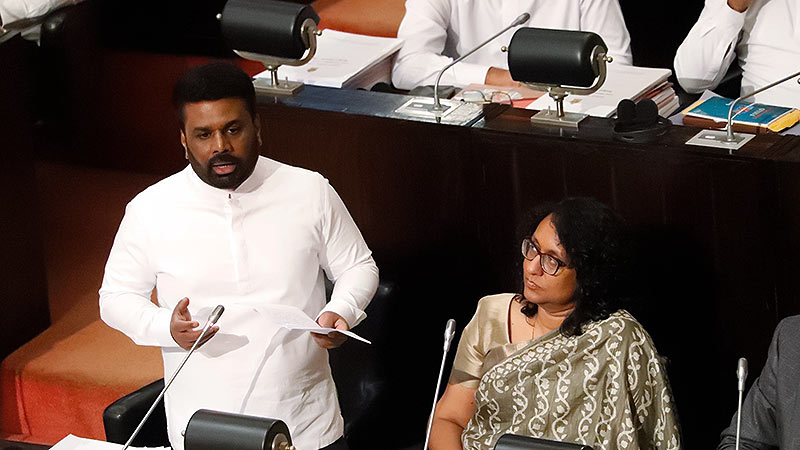Sri Lankan President clarifies economic status in 2025 Budget speech

Sri Lankan President Anura Kumara Dissanayake presented the first national budget of his government in Parliament today (February 17), emphasizing economic recovery, social justice, and sustainable growth.
The President highlighted the challenges faced by Sri Lanka following its severe socio-economic and political crisis in 2022, attributing the crisis to historical and structural issues, including corruption, failed economic policies, and mismanagement of public finances.
Addressing the Aftermath of the 2022 Crisis
The President recalled the hardships endured by the people due to shortages of essential goods, fuel, and medicines, which particularly affected vulnerable groups such as women, children, the elderly, and the disabled. He acknowledged that while the economic situation has stabilized, the crisis has evolved into a humanitarian issue impacting the most impoverished sections of society.
The political shift following the 2022 crisis led to the establishment of a temporary government, which, according to the President, failed to fulfill the people’s aspirations. However, he asserted that the 2024 presidential and general elections marked a turning point, with the public decisively voting for a government committed to economic and political transformation.
Stabilizing the Economy and Building Investor Confidence
President Dissanayake dismissed fears spread by political opponents that the economy would further deteriorate under his leadership. Contrary to such claims, the government successfully stabilized the financial sector, with the Treasury bill rate reducing to 8.8 percent and foreign reserves increasing to USD 6.1 billion by the end of 2024. Additionally, the Sri Lankan Rupee has strengthened to approximately LKR 300 per USD, and the country is projected to achieve 5 percent economic growth in 2025.
The President also highlighted the successful conclusion of the debt restructuring process in December 2024. The restructuring has provided significant debt relief, reducing repayment costs and creating fiscal space for development initiatives. As a result, Sri Lanka’s credit ratings have improved, bolstering investor confidence and trade opportunities.
Challenges and Social Welfare Initiatives
Despite economic stabilization, the President acknowledged that many citizens continue to struggle due to rising living costs. Inflation, which peaked at 70 percent in 2022, has decreased, but prices remain high, affecting living standards. In response, the government has increased financial assistance through the Aswesuma program and pledged a fair wage increase to counter the decline in real wages.
However, the President stressed that cash transfers are not a long-term solution to poverty. He emphasized the need for sustainable economic opportunities, particularly for the marginalized, and vowed to correct errors in the welfare system to ensure aid reaches the most deserving individuals.
Key Budget Priorities and Economic Vision
The 2025 budget focuses on economic growth driven by industry, services, and agriculture. The government aims to ensure that production actively involves the people and that the benefits are equitably shared across society. On the demand side, the government is committed to maintaining a steady supply of essential goods and services at fair prices and acceptable quality standards.
The budget incorporates the following mechanisms to achieve these objectives:
- Strengthening market competition
- Government regulation and monitoring
- Direct government participation in key economic areas
- Organizing production in strategic sectors
The government plans to invest in infrastructure, education, and healthcare to empower people economically. It also intends to support small and medium enterprises (SMEs), rural development, local entrepreneurship, and research-driven innovation.
Fiscal Discipline and Governance Reforms
The President emphasized fiscal responsibility, noting that the budget is prepared within strict financial constraints. The Public Financial Management Act mandates a primary expenditure limit of 13 percent of GDP, which the government has adhered to. Despite these limitations, funds have been allocated for social welfare programs, senior citizens’ benefits, and capital expenditure to drive economic growth.
Additionally, President Dissanayake reaffirmed his commitment to eliminating corruption and wasteful spending. The Clean Sri Lanka initiative aims to enhance transparency and good governance, ensuring that public funds are used effectively.
Medium-Term Economic Goals
Looking ahead, the government expects sustained economic growth of over 5 percent, with a focus on:
- Expanding export revenue to USD 19 billion in 2025
- Reducing poverty, which peaked at 25.9 percent in 2023
- Enhancing foreign investment and business confidence
- Strengthening social safety nets and public services
The government’s broader economic strategy includes digitalization, sustainable development, and green economy initiatives. By improving investment conditions and governance, Sri Lanka aims to achieve long-term economic stability and prosperity.
A Call for Patience and Unity
President Dissanayake urged citizens to remain patient and work collectively towards economic recovery. He emphasized that while rebuilding the economy is a challenging process, disciplined financial management and strategic reforms will lead to long-term benefits for all Sri Lankans.
With these commitments, the President presented the 2025 Budget to Parliament, marking a new phase in Sri Lanka’s economic and social transformation.
Read the complete 2025 Budget speech by Sri Lankan President Anura Kumara Dissanayake here.
Latest Headlines in Sri Lanka
- Sri Lankan President orders swift livelihood restoration for disaster-hit communities December 13, 2025
- Sri Lanka receives over USD 7 Billion in remittances in 2025 December 13, 2025
- Sri Lanka Parliament summoned to meet on December 18 December 13, 2025
- Sri Lanka and Italy renew agreement on mutual recognition of driving licenses December 13, 2025
- Asoka Ranwala granted bail December 12, 2025


